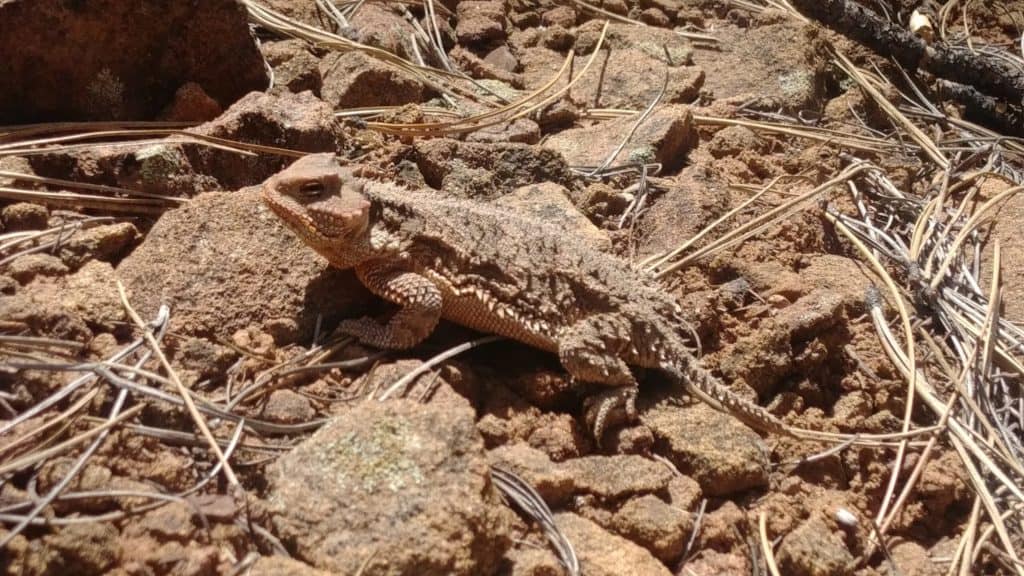A couple weeks ago, I found myself taking a break under a large piñon tree at Base Camp. With summer treks cancelled due to the pandemic, a lot of our time has been spent working hard on infrastructure projects such as tilling the farm or preparing lumber. At 10:30 AM, I already needed a breather after making a few batches of adobe bricks. Our adobe pit doesn’t have any shade and the days have been heating up recently. I wasn’t thinking about it at the time, but with the rising heat our reptilian neighbors have been getting more active all over Base Camp. Break time was over and more bricks weren’t going to make themselves. As I got up, my eyes caught motion just in front of me. My heart skipped a beat…an enormous snake was slithering past! I had never seen a snake like this before and was momentarily in awe of this nearly 4 foot long predator with striking yellow and brown patterning. For it’s part, the snake didn’t seem bothered by me and just maintained it’s direct course to shade. Given the heat, I can appreciate it’s priorities. I hastily grabbed a couple pictures and a short video from a respectful distance before this incredible creature slunk out of sight. I wanted to know more about what I’d seen, so I decided to try uploading my images to the iNaturalist community science app. To my surprise, in only a couple hours multiple people had identified this specimen as a Bull Snake.
With this new identification, I was able to look up more information and satisfy the curiosity I had about the snake. It turns out the Bull Snake has other impressive qualities in addition to it’s striking coloration and size. The Bull Snake is a nonvenomous species that relies on it’s bulk to ward off potential predators. However, the Bull Snake isn’t just all brawn. It has cleverly learned to imitate rattlesnakes by flattening it’s head and coiling up when it feels threatened. This bluff is further solidified by an enlarged epiglottis which amplifies its hissing, as well as the snake’s tendency to quickly rustle it’s tail in the grass to mimic the sound of a rattle. There is a common misconception that Bull Snakes prey on or regularly conflict with rattlesnakes. In truth, they feed on small mammals and are an important predator in ecosystems all across the United States.
The next day, I had hiked up to the top of the mesa at the end of the work day. I had been out at Base Camp for a while and before bed thought it would be nice to indulge in some cell phone service and get in touch with my family back home. I told them about the fun work and exciting snake encounter that had happened recently. As I hung up the phone, I wasn’t aware that I was about to have another reptile encounter. In the fading light, I began my scramble down the mesa and jumped back as I heard a startling rattle sound. This was no Bull Snake mimicry, it was the real thing: a Western Rattlesnake (also called a Prairie Rattlesnake). This one in particular didn’t seem too pleased that I was within three feet of it and let me know by striking a menacing coiled pose with it’s rattle raised behind it. This wasn’t the time for pictures, I quickly backed off and gave the rattlesnake space to enjoy it’s evening in peace.
After digging through some musty textbooks in the museum, I was able to find more information on this intimidating predator. The Western Rattlesnake is one of the most widespread rattlesnake species. It even has a unique ability to change its sleep cycle to adjust to the intense climate of New Mexico. In spring and fall, this species is diurnal, or active during the day. However, in summer months it becomes nocturnal to beat the desert heat. The Western Rattlesnake is also a flexible hunter and will both actively investigate rodent burrows for prey, but also use ambush tactics when it finds an area where rodents have been frequently crossing. With venom consisting of both hemotoxins and neurotoxins, the bite of the Western Rattlesnake is nothing to take lightly. It might sound easy to be afraid of the Western Rattlesnake but we ought to be thankful to it for keeping local rodent populations in check. The life of a predator is tough work and so it’s not uncommon to find the Western Rattlesnake relaxing and warming itself on blacktop roads at night after a long summer day. So, unless you want mice overrunning your next picnic, remember to drive slow and watch out for our slithering neighbors.

After the previous two snake encounters that week, I was ready on Saturday with my camera for any nature encounters when I went hiking in the Cibola National Forest connected to Base Camp. Less than fifteen minutes into my hike my eyes caught the distinctive spiny shape of a horned lizard scuttling across the trail. As I leaned in for a closer look and a decent picture, the horned lizard relied on it’s excellent camouflage and tried to blend in with the rust-colored Zuni sandstone on the ground. The next morning, I uploaded my picture to iNaturalist where the species was quickly identified as the Greater Short-Horned Lizard. While it’s not as potent as a Western Rattlesnake, the 5-inch long Greater Short-Horned Lizard is a respectable predator in its own right and mostly feeds on beetles and ants. I was already impressed with the natural camouflage of the Greater Short-Horned Lizard, but I learned that it has an even more impressive defense mechanism: autohaemorrhaging, also known as reflex bleeding. In a pinch, the Greater Short-Horned Lizard can rupture blood vessels near its eyes to shoot blood up to 5 feet at whatever is threatening it. This behavior has been observed to be particularly effective at repelling coyotes, foxes and dogs. Be sure to keep your furry friend on a short leash if you stumble upon a Greater Short-Horned Lizard on your next hike!
Over the course of two weeks at Base Camp, I felt incredibly fortunate to have all of these exciting encounters in nature. Our reptile neighbors will be here the next time you are out at Base Camp! These species just scratch the surface of the astounding biodiversity of the Southwest. We just have to keep our eyes open to see and our minds open to learn about the amazing natural world we all share.
If you want to identify animals or plants you’ve seen in nature or participate in citizen science through iNaturalist, click here to see an interactive iNaturalist tutorial from the Bachechi Open Space Saturday Speaker Series.
And for more information about our local reptilian neighbors, tune into this Saturday May 16 at 10AM MST to the Bachechi Open Space Facebook page to hear from local scientists about the Herpetology of the Rio Grande Valley Bosque
Ben joined Cottonwood Gulch in Fall of 2019 as a field educator and now works as our Marketing Coordinator.

